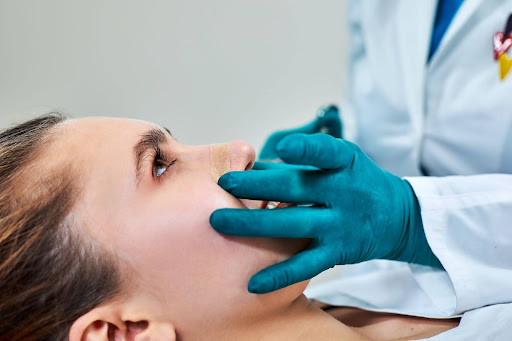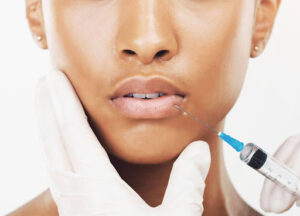The recovery process after rhinoplasty requires patience and adherence to your surgeon’s instructions. Removing the nasal cast is a significant milestone, but continued care is necessary to ensure optimal results. With the right approach and guidance, patients can achieve their aesthetic beauty goals and enjoy improved breathing and nasal function. In this article, we explain the rhinoplasty aftercare process, including crucial considerations regarding cast removal.
The Role of a Nasal Cast in Rhinoplasty Recovery
The nasal cast is a vital part of the rhinoplasty recovery process, offering necessary support and protection to ensure optimal healing and results. Proper care and adherence to your surgeon’s instructions regarding the nasal cast can significantly impact the success of rhinoplasty surgery.
Purpose of a Nasal Cast
The nasal cast is a hard, protective cover placed over the nose immediately after rhinoplasty surgery. Its primary functions are:
- Support and Stabilization: It helps maintain the new shape of the nasal bones and cartilage, preventing any movement that could disrupt the surgical outcomes.
- Protection: It safeguards the nose from accidental bumps and external pressure that could affect the delicate healing process.
- Minimizing Swelling: The cast applies gentle pressure, which helps reduce swelling and aids in proper healing.
Material and Application
- Material: Typically made from materials like plastic or fiberglass, the cast is lightweight yet sturdy enough to provide the necessary support.
- Application: Applied immediately after the surgical procedure while the patient is still under anesthesia. It covers the bridge of the nose and extends to the sides, ensuring comprehensive protection.
Duration of Use
- Initial Days: The nasal cast is usually kept in place for about 1-2 weeks after surgery. During this period, it is crucial to keep the cast dry and avoid any pressure on the nose.
- Removal: Cast removal is done during a follow-up appointment with the surgeon. This process is generally quick and painless.
What is the Right Age for a Nose Job?
The Nasal Cast Post-Surgery: A Rhinoplasty Operation Aftercare Timeline
After rhinoplasty, a nasal cast is applied to maintain the position of the nasal bones and support the delicate structures of the nose. This cast plays a vital role in the healing process, ensuring that the nose maintains its new shape during the initial recovery phase.
Days After Surgery: Immediate Post-Operative Care
In the first days after surgery, patients will experience swelling, nasal congestion, and possibly some bloody drainage. It’s essential to follow detailed aftercare instructions provided by your surgeon to minimize complications. Keeping the cast dry and avoiding any pressure on the nose is critical during this period.
The First Week After Surgery: Managing Swelling and Pain
During the 1st week, swelling and pain are common. Patients are advised to use cold compresses and keep their heads elevated, possibly with 4-5 pillows or an airplane neck pillow, to reduce swelling. Avoiding strenuous activities and movements that could dislodge the cast is crucial. Any narcotic pain medications prescribed should be taken as directed.
1-2 Weeks After Surgery: Cast Removal Appointment
Typically, the nasal cast is removed 1-2 weeks after surgery during a follow-up appointment with your surgeon. This timing can vary based on the individual’s healing process and the specific surgical techniques used. It’s common for patients to feel nervous about this appointment, but removing the cast is usually quick and relatively painless.
Weeks After Surgery: Ongoing Healing and Activity Restrictions
Even after the cast is removed, the nose is still in a delicate healing process. Swelling will continue to subside over the next several weeks, and patients should avoid any activities that could impact the nose, such as wearing glasses that rest on the nasal bridge or engaging in strenuous exercises.
1-3 Months After Surgery: Resuming Normal Activities
Over the 1-3 month period, patients will gradually return to their normal routines. Light glasses can be worn, but it’s important to continue avoiding any physical activity that could put the nose at risk. The nasal skin and tissues are still healing, and the final results of the surgery won’t be fully visible until the swelling has completely subsided.
How Long Is Recovery From Rhinoplasty?
Common Questions About Cast Removal and Aftercare
How do I care for my nose after the cast is removed?
After the cast removal, follow your surgeon’s aftercare instructions carefully. Use gentle pressure when cleaning the nasal area and avoid any direct impact to the nose. Keep the area clean and dry, and avoid using hot water or harsh facial products. Cold compresses can help reduce residual swelling and discomfort.
Can I wear glasses after the cast is removed?
It’s best to avoid wearing glasses that rest on the nasal bridge for several weeks after cast removal. Your surgeon may provide specific advice or alternative options, such as using a special nasal splint designed to distribute the weight of the glasses without impacting the healing nose.
When can I resume physical activities?
Strenuous activities, including aerobic exercises and heavy lifting, should be avoided for at least 4 to 6 weeks. This includes activities like running, swimming, and heavy household chores. Consult your surgeon for personalized advice based on your recovery progress. Gradually reintroduce physical activities, starting with light exercises and avoiding anything that could cause nasal trauma.
How long will swelling last?
Swelling can persist for several months after surgery. Most noticeable swelling subsides within the first few weeks, but residual swelling can take up to a year to fully resolve. Asymmetric swelling and minor nasal congestion are common during this period.
Can I fly on an airplane after cast removal?
Flying shortly after rhinoplasty can increase nasal swelling due to changes in cabin pressure. It’s advisable to wait at least 2-3 weeks before flying. Always consult with your surgeon before planning any travel.
What should I do if I experience pain or discomfort?
Mild discomfort and pain are normal after cast removal. Over-the-counter pain medications, such as acetaminophen, can help manage this. Avoid taking NSAIDs like ibuprofen unless advised by your surgeon, as they can increase the risk of bleeding. If you experience severe pain, contact your surgeon immediately.
How do I handle nasal congestion post-surgery?
Nasal congestion is common after rhinoplasty due to swelling and internal splints. Saline sprays and gentle nasal irrigation can help alleviate congestion. Avoid blowing your nose forcefully for at least a few weeks after the cast is removed.
When can I resume normal daily activities?
You can resume most normal daily activities, such as gentle walking and light household tasks, within a few days after cast removal. Avoid activities that involve bending over or lifting heavy objects for at least 4-6 weeks.
What signs should I watch for that indicate a problem?
Watch for signs of infection, such as increased redness, swelling, warmth, or colored drainage from the nose. If you experience persistent bleeding, severe pain, or difficulty breathing, contact your surgeon immediately.
How long should I avoid sun exposure?
Avoid direct sun exposure to your nose for at least three months after surgery, as it can cause swelling and affect the healing process. When outdoors, use a high-SPF sunscreen and wear a wide-brimmed hat.
When will I see the final results of my rhinoplasty?
Final results can take up to a year to fully manifest, as residual swelling gradually subsides and the nasal tissues settle into their new form. Regular follow-up appointments with your surgeon will help monitor your progress.
Rhinoplasty Services in Montreal
Clinique Face MD performs rhinoplasty procedures tailored to your functional and aesthetic goals. Whether you are considering revision rhinoplasty, ultrasonic rhinoplasty, a non-surgical nose job, or anything in between, our team is here for you. Book a personalized consultation today and take the first step towards your desired look!





